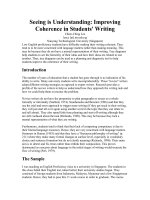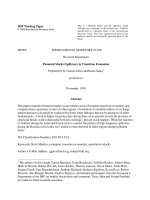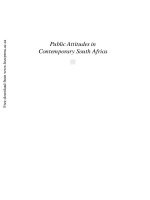Springer Series in Advanced Manufacturing_8 doc
Bạn đang xem bản rút gọn của tài liệu. Xem và tải ngay bản đầy đủ của tài liệu tại đây (1.32 MB, 21 trang )
Cross-cultural Analysis of ERP Implementation 193
Table 11.1. (continued)
Study
Methodology
Critical Success Factors Identified
Roseman et al.
(2001)
Literature Review
Developed a priori model for process modelling
success factors derived from the literature:
x Modelling methodology, modelling
language, modelling tool, modeller
’s
expertise, modelling team orientation
x Project management, user participation,
top management support
Allen et al.
(2002)
Case study
(4 higher education
institutions)
Identified ERP critical success factors for public
organisations:
x Strategic: project schedule/plans, ERP
strategy, mission, top management
support
x Contextual: organisational culture,
constructions of past, technological
implementations, political structures
x Tactical: relationship and knowledge
management, business process changes
and software configuration, technical
tasks, client acceptance, monitoring and
feedback, troubleshooting,
x Communication
Al-Mashari et
al. (2003)
Literature Review
Developed a taxonomy of ERP critical success
factors to demonstrate the linkages between ERP
critical success factors, ERP success and ERP
benefits:
x Setting-up: management and leadership,
visioning and planning
x Deployment: ERP package selection,
communication, process management,
training and education, project
management, legacy systems
management, system integration, system
testing, cultural and structural changes
x Evaluation: performance evaluation and
management
194 J. Motwani, A.Y. Akbulut and M. Argyropoulou
Table 11.1. (continued)
Study
Methodology
Critical Success Factors Identified
Brown and
Vessey (2003)
Case study
(3 organisations)
Identified five factors for successful ERP
implementations:
x Top management is engaged in the
project, not just involved
x Project leaders are veterans, and team
members are decision makers
x Third parties fill gaps in expertise and
transfer their knowledge
x Change management goes hand-in-
hand with project planning
x A satisfying mindset prevails
Umble et al.
(2003)
Case Study
(1 organisation)
Identified critical factors for successful ERP
implementations
x Clear understanding of strategic goals,
commitment by top management,
excellent project management,
organisational change management, a
great implementation team, data
accuracy, extensive education and
training, focused performance
measures, multi-site issues
Somers and
Nelson (2004)
Survey
(116 organisations)
Identified and tested the relative importance of
the key players and activities across the ERP
project life cycle, which affect the success of these
projects.
x Key players: top management, project
champion, steering committee,
implementation consultants, project
team, vendor-customer partnerships,
vendors’ tool, and vendor support
x Key activities: user training and
education, management of
expectations, careful selection of the
appropriate package, project
management, customisation, data
analysis and conversion, business
process re-engineering, defining
architecture, dedicating resources,
change management, establishing clear
goals and objectives, education on new
business processes, interdepartmental
communication and cooperation
Cross-cultural Analysis of ERP Implementation 195
Table 11.1. (continued)
Study
Methodology
Critical Success Factors Identified
Gargeya and
Brady (2005)
Content analysis
(Secondary data
pertaining to SAP
implementations in 44
companies)
Identified six common factors that are indicative
of successful or non-successful SAP
implementations:
x Lack of appropriate culture and
organisational readiness is the most
important factor contributing to failure
of SAP implementations
x The presence of project management
approaches and appropriate culture and
organisational readiness are the most
important factors contributing to the
success of SAP implementations
Motwani et al.
(2005)
Case study
(1 organisation)
Identified the factors that facilitated the success of
ERP implementations and examined the factors
that initially inhibited the success of the
implementation process and explained how these
barriers were overcome.
x Strategic initiatives, learning capacity,
cultural readiness, IT leveragability
and knowledge sharing capacity,
network relationships, change
management practices, process
management practices
Tsai et al. (2005)
Survey
(multiple organisations)
Identified the critical factors causing failure in
the implementation of the enterprise resource
planning (ERP) system. Suggested that companies
should focus on improving the management of
these failure factors to increase the rate of
success in the implementation of the ERP systems.
x Time frame and project management
x Personnel training
x Change management
196 J. Motwani, A.Y. Akbulut and M. Argyropoulou
Table 11.2. Major Studies Examining the Role of Culture in ERP Implementations
Study
Methodology
Findings
Soh et al.
(2000)
Case study
(1 organisation)
Discussed the cultural misfits of ERP packages from a
Singaporean perspective. Identified the:
x Different types of misfits employed: data,
process, and output
x Resolution strategies employed
x Impacts on organisations
Huang and
Palvia (2001)
Literature Review
and Theoretical
Framework
Development
Identified a range of issues concerning ERP
implementations by making a comparison of advanced
and developing countries.
x National and environmental factors:
o Current economic status and
economic growth
o Infrastructure
o Government regulations
x Organisational and internal factors
o Low IT maturity
o Small firm size
o Lack of process management and
BPR experience
Davison
(2002)
Case study
(1 organisation)
Compared educational ERP system implementation
practices in North America and Hong Kong. Identified
certain differences along the following dimensions:
x Access to information
x Homonyms (meanings associated with
numbers)
x Re-engineering and empowerment
Martinsons
(2004)
Case study
(8 organisations)
Review of the
results of a survey
(189 organisations)
Investigated the ERP implementations in China,
comparing the practices of state-owned enterprises and
private enterprises.
x There is a poor fit between ERP systems and
traditional Chinese management systems.
x Identified 8 differences between state-owned
and private enterprises in terms of: Primary
project aims, role of top management, role of
steering committees, role of consultants,
scope of implementation, pace of
implementation, implementation problems,
and evaluation and outcomes.
O’Kane and
Roeber
(2004)
Case study and
Survey
(1 organisation)
Focused on an ERP implementation in a Korean company
x Determined what impact natural culture has on
the implementation process of ERP systems by
testing some of the propositions developed by
Davison (2002) and Martinsons (2004).
Cross-cultural Analysis of ERP Implementation 197
Table 11.2. (continued)
Study
Methodology
Findings
Reimers
(2003)
Survey
(80 organisations)
Investigated the crucial implementation process and
context variables which warrant closer study of ERP
enabled organisational change in China.
x Ownership is strongly associated with
implementation process characteristics
x Project governance (role and decision making
style of steering committee) affects
implementation success
Liang et al.
(2004)
Interviews
(5 organisations)
Investigated the five companies that attempted to
implement foreign ERP systems with unsuccessful results.
Identified the following types of problems for failure:
x Language problems
x Report format and content problems
x Cost control module problems
x Price problems
x Business process redesign problems
x Customer support problems
x Consulting partner problems
Rajapakse
and Seddon
(2005)
Case study
(6 organisations)
Utilizing Hofstede’s dimensions of national culture,
investigated the impact of national and organisational
culture on the adoption of western-based ERP software in
developing countries in Asia.
x The findings revealed a clash of cultural forces
between the culture embedded in western
products and the culture of Asian ERP
adopters.
x Four pairs of opposing cultural forces work
against ERP implementations in Asia:
o Centralized vs. decentralized
o Low vs. high level of accountability
and discipline
o Low vs. high level of commitment
o Low vs. high level of change
198 J. Motwani, A.Y. Akbulut and M. Argyropoulou
11.6 References
Allen D, Kern T, Havenhand M, (2002) ERP Critical Success Factors: An exploration of the
Contextual Factors in Public Sector Institutions. Proceedings of the 35th Hawaii
International Conference on System Sciences
Al-Mashari M, Al-Mudimigh A, Zairi M, (2003) Enterprise resource planning: A taxonomy
of critical factors. European Journal of Operational Research 146(2):352–364
Amin, N, Hinton M, Hall P, Newton M, Kayae R, (1999) A Study of Strategic and Decision-
Making Issues in Adoption of ERP Systems Resulting from a Merger in the Financial
Services Sector. 1
st
International Workshop on Enterprise Management Resource and
Planning Systems (EMRPS), Venice, Italy:173–181
Bingi P, Sharma M, Godla J, (1999) Critical Issues Affecting an ERP Implementation.
Information Systems Management 16:3:7–8
Brown C, Vessey I, (1999) ERP Implementation Approaches: Toward a Contingency
Framework. Proceedings of the International Conference on Information Systems:411–
416
Brown C, Vessey I, (2003) Managing the Next Wave of Enterprise Systems: Leveraging
Lessons from ERP. MIS Quarterly Executive 2(1):65–77
Davison R, (2002) Cultural Complications of ERP. Communications of the ACM 45:7:109–
111
De Mooij M, (2000) The future is predictable for international marketers: Converging
incomes lead to diverging consumer behavior. International Marketing Review 17
(2):103–113
Dubé L, Paré G, (2003) Rigor in Information Systems Positivist Case Research: Current
Practices, Trends, and Recommendations. MIS Quarterly 27(4):597–635
Eisenhardt KM (1989) Building Theories from Case Study Research. The Academy of
Management Review 14(4):532–550
Esteves J, Pastor J, (2000) Towards unification of critical success factors for ERP
implementations. Proceedings of the 10th Annual Business Information Technology
(BIT) Conference, Manchester, UK:44–52
Esteves J, Pastor J, (2001) Enterprise resource-planning systems research: an annotated
bibliography. Communications of the AIS 78:1–52
Gargeya VB, Brady C, (2005) Success and failure factors of adopting SAP in ERP system
implementation. Business Process Management Journal 11(5):501–516
Hofstede G, (1991) Culture and organisations: Software of the mind. London, UK: McGraw
Hill
Hofstede G, (2001) Culture’s Consequences: Comparing Values, Behaviors, Institutions,
and Organisations across Nations. 2nd Ed., Sage Publications, London, England
Holland C, Light B, (1999) Critical Success Factors Model for ERP Implementation. IEEE
Software May/June:1630–1636
Huang Z, Palvia P, (2001) ERP implementation issues in advanced and developing
countries. Business Process Management Journal 7(3):276–84
Klaus H, Rosemann M, Gable GG, (2000) What is ERP?. Information Systems Frontiers
2(2):141–162
Lee A, (2000) Researchable Directions for ERP and Other New Information Technologies.
MIS Quarterly 24(1):3–8
Liang H, Xue Y, Boulton WR, Byrd TA, (2004) Why Western vendors don't dominate
China's ERP market?. Communications of the ACM 47(7):69–72
Maitland C, Bauer J, (2001) National level culture and global diffusion: The case of the
Internet. In Charles Ess (Ed.), Culture, technology, communication: Towards an
intercultural global villagew. Albany, NY: State University of New York Press:87–128
Cross-cultural Analysis of ERP Implementation 199
Markus ML, Tannis C, (2000) The Enterprise Systems Experience – From Adoption to
Success. In Framing the Domains of IT Research: Glimpsing the Future through the Past,
R. W. Zmud (Ed.), Cincinnati, OH: Pinnaflex Educational Resources, Inc.
Martinsons MG, (2004) ERP in China: One Package, Two Profiles. Communications of the
ACM 47(7):65–68
Molla A, Loukis I, (2005). Success and Failure of ERP Technology Transfer: A Framework
for Analyzing Congruence of Host and System Culture. Development Informatics
Working Paper Series
Motwani J, Akbul AY, Nidumolu V, (2005) Successful implementation of ERP systems: a
case study of an international automotive manufacturer. International Journal of
Automotive Technology and Management 5(4):375–386
Murray MG, Coffin GWA, (2001) Case Study Analysis of Factors for Success in ERP
System Implementations. Proceedings of the Americas Conference on Information
Systems, August 3-5, Boston, Massachusetts:1012–1018
O’Kane JF, Roeber M, (2004) ERP Implementations and cultural influences: a case study.
2nd world conference on POM, Cancun, Mexico
Parr A, Shanks G, (2000) A Model of ERP Project Implementation. Journal of Information
Technology 15:289–303
Rajapakse J, Seddon PB, (2005) ERP Adoption in Developing Countries in Asia: A Cultural
Misfit. Available at accessed
12/10/07
Reimers K, (2003) International Examples of Large-Scale Systems – Theory and Practice I:
Implementing ERP Systems in China. Communications of the AIS 11(20):335–356
Robey D, Ross J, Boudreau M, (2002) Learning to Implement Enterprise Systems: An
Exploratory Study of the Dialectics of Change. Journal of Management Information
Systems 19(1):17–46
Roseman M, Sedera W, Gable G, (2001) Critical Success Factors of Process Modeling for
Enterprise Systems. Proceedings of the Americas Conference on Information Systems,
August 3-5, Boston, Massachusetts:1128–1130
Sankar CS, Raju PK, Nair A, Patton D, Bleidung N, (2005) Enterprise Information Systems
and Engineering Design at Briggs & Stratton: K11 Engine Development. JITCAR,
7(1):21–38
Sharma R, Palvia P, Salam AF, (2002) ERP Selection at Custom Fabrics. JITCA 4(2):45–59
Soh C, Kien SS, Tay-Yap J, (2000) Enterprise Resource Planning: Cultural Fits and Misfits:
Is ERP a Universal Solution?. Communications of the ACM 43(4):47–51
Somers TM, Nelson KG (2004) A taxonomy of players and activities across the ERP project
life cycle. Information and Management 41:257–278
Sumner M, (2004) Enterprise Resource Planning. Pearson, Prentice Hall, Upper Saddle
River, New Jersey
Tatsiopoulos I, Panayiotou N, Kirytopoulos K, Tsitsiriggos K, (2003) Risk Management as a
Strategic Issue for the Implementation of ERP Systems: A Case Study from the Oil
Industry. International Journal of Risk Assessment and Management 4(1):20–35
Tsai W, Chien S. Hsu P, Leu J, (2005) Identification of critical failure factors in the
implementation of enterprise resource planning (ERP) system in Taiwan's industries.
International Journal of Management and Enterprise Development 2(2):219–239
Umble E, Haft R, Umble M, (2003) Enterprise Resource Planning: Implementation
Procedures and Critical Success Factors. European Journal of Operational Research
146(2):241–257
Veiga JF, Floyd S, Dechant K, (2001) Towards modelling the effects of national culture on
IT implementation and acceptance. Journal of Information Technology 16(3):145–158
200 J. Motwani, A.Y. Akbulut and M. Argyropoulou
Xue Y, Liang H, Boulton WR, Snyder CA, (2005) ERP Implementation Failures in China:
Case studies with Implications for ERP Vendors. International Journal of Production
Economics 97(3):279–295
Yin R, (2003) Case Study Research: Design and Methods. Sage Publications, California
Appendix
Utilisation of Suchman’s Paper
Séverine Le Loarne
1
, Audrey Becuwe
2
1
Grenoble Ecole de Management
2
Ecole des Dirigeants et Créateurs d'Entreprise (EDC Paris)
Table A.1 Utilisation of Suchman's paper
Authors, date
and review of
publication
Object of
article
Mobilisation and quotation
of Suchman’s paper
Thesis of article
and results
Pourder R.,
John CHS,
(1996),
Academy of
Management
Review
Develop an
evolutionary
model that
contrasts hot
spot and non-
hot spot
competitors
within the same
industry.
“As the emerging industry sub-
population gains legitimacy
within the region, access to
capital and market improves”.
Initially,
economies of
agglomeration,
institutional
forces, and
managers’ mental
models create an
innovative
environment
within the hot
spot. Over time,
those same forces
create a
homogeneous
macroculture that
suppresses
innovation,
making hot spot
competitors more
susceptible that
non-hot spot
competitors to
environment
jolts.
202 Appendix
Table A.1 (continued)
Authors, date
and review of
publication
Object of
article
Mobilisation and quotation
of Suchman’s paper
Thesis of article
and results
Brown AD,
(1997),
Academy of
Management
Review
Theory of
narcissism
employed to
analyse the
dynamics of
group and
organisational
behaviour.
“the idea that organisation
must exhibit ‘congruence’ or
‘isomorphism’ with the social
values and norms of
acceptable behaviour in the
larger social system is well
established”
The use of Suchman’s article
is very generic. It is not related
to the topic of legitimacy but
on how organisations adapt
themselves to social norms and
values.
Organisational
identification
permits
organisational
legitimisation.
Reed R, Lemak
DJ, Hesser WA,
(1997),
Academy of
Management
Review
Shift in mission
of the U.S.
nuclear
weapons
complex from
the production
of nuclear
materials and
weapons to one
of
environmental
cleanups.
“legitimacy rests on a
foundation of satisfying the
self-interests of the
organisation’s audiences,
having a positive evaluation of
the organisation and its
activities, and receiving
positive backing”.
Draw attention to
the management
and social issues
the complex is
facing in the
related areas of
organisation-
culture change,
the public’s
health fears and
the management
of risks.
Sahay S,
Walsham G,
(1997),
Organization
Studies
Social structure
and managerial
agency in India.
Describe possible
influences that
social structure
has on the
shaping of
managerial
attitudes in India.
This framework
is then used to
provide the lens
through which a
specific Indian-
government-
initiated,
information-
technology
project is
analysed.
Appendix 203
Table A.1 (continued)
Authors, date
and review of
publication
Object of
article
Mobilisation and quotation
of Suchman’s paper
Thesis of article
and results
Ruef M, Scott
WR, (1998),
Administrative
Science
Quaterly
Organisational
legitimacy: the
antecedents and
effects of two
forms of
organisational
legitimacy:
managerial and
technical.
Three quotations:
-“these and related
contributions represent
considerable diversity but also
reflect a common underlying
conception, which has been
formulated by Suchman as
follows: “legitimacy is a
generalised perception or
assumption that the actions of
an entity are desirable, proper,
or appropriate within some
socially constructed system of
norms, values, beliefs and
definitions”.
-“As Suchman noted,
legitimacy is a “generalised
perception” representing the
“reactions of observers to the
organisation as they see it,
thus, legitimacy is possessed
objectively, yet created
subjectively”
-“As Oliver (1991) and
Suchman (1995) have
proposed and Elsbach and
Sutton (1992) have
demonstrated, organisations
are not simply passive
recipients in legitimisation
processes but work actively to
influence and manipulate the
normative assessments they
receive from their multiple
audiences”
So, Ruef and Scott use the
legitimacy definition of
Suchman.
The antecedents
of legitimacy
vary, depending
on the nature of
the institutional
environment as
well as the
organisational
function that is
being
legitimated.
204 Appendix
Table A.1 (continued)
Authors, date
and review of
publication
Object of
article
Mobilisation and quotation
of Suchman’s paper
Thesis of article
and results
Barron DN,
(1998),
Organization
Studies
Processes by
which two
organisational
forms in New
York City can
become
legitimate:
credit unions
and the Morris
Plan Bank.
-“Second, although ecologists
have tended to see legitimacy
as cognitive, other scholars
have considered it to imply
moral or pragmatic
acceptance of an
organisational form (Suchman
1995)”.
-“Following Suchman (1995),
I call these three forms
pragmatic, moral, and
cognitive legitimacy,
respectively. Pragmatic
legitimacy 'rests on the self-
interested calculations of an
organisation's most immediate
audiences' (Suchman, 1995:
578)”.
-“Potential members,
customers, or sponsors of an
organisation must believe that
such an involvement will be in
their interests. Moral
legitimacy 'reflects a positive
normative evaluation of the
organisation and its activities'
(Suchman, 1995: 579). This is
perhaps the definition of
legitimacy that is closest to its
meaning in common usage”
.
Various
mechanisms
affected different
types of
legitimacy
Mone MA,
McKinley W,
Barker III VR,
(1998),
Academy of
Management
Review
Organisational
decline
“institutional theorists point
out that organisations are
subject to institutionalised
expectations about what
behaviours they can pursue
legitimately”
Develop a
contingency
model which
identifies
variables as the
environmental,
organisational
and individual
levels of analysis
that determine
whether
organisational
decline inhibits
or stimulate
innovation.
Appendix 205
Table A.1 (continued)
Authors, date
and review of
publication
Object of
article
Mobilisation and quotation
of Suchman’s paper
Thesis of article
and results
Beckert J,
(1999),
Organization
Studies
Question of
how to deal
with interest-
driven
behaviour and
institutional
change
“Even if entrepreneurs reflect
upon the constraining qualities
of institutionalised practices,
and “management of
legitimacy” (Suchman, 1995)
has to take into account the
negative consequences
resulting from violations of
institutionalised demands”.
Develop an
integrative
concept which
theorises the
connection of
strategic agency
and institutions in
a model of
institutional
change.
Kostova T,
Zaheer S,
(1999),
Academy of
Management
Review
Organisational
legitimacy
“ traditionally, researchers
have examined legitimacy at
two levels: (1) at the level of
classes of organisations and,
(2) at the organisational level
(Suchman, 1995)”
.
Obtaining
legitimacy is both
a socio-political
and cognitive
process through
which the
environment and
the organisation
continually test
and redefine the
legitimisation
process. The
organisation is
involved in a
continual process
of interpreting
and influencing
its own actions as
they are related
to the
legitimising
requirements of
the larger
environment.
206 Appendix
Table A.1 (continued)
Authors, date
and review of
publication
Object of
article
Mobilisation and quotation
of Suchman’s paper
Thesis of article
and results
Scott SG, Lane
VR, (2000),
Academy of
Management
Review
Analyse
organisational
identity from
the perspective
of manager-
stakeholder
relationships.
“ similar to legitimacy,
organisational identity is
objectively held – that is, it has
a reality independent of
individual observers –
although it is subjectively
arrived at.”
Develop a model
of organisational
identity
construction that
reframes
organisational
identity within
the broader
context of
manager-
stakeholder
relationships, and
which draws
attention to
organisational
identity as
negotiated
cognitive images
and to
embeddedness of
organisational
identity within
different systems
of organisational
membership and
meaning.
McKinley W,
Zhao J, Garrett
Rust K, (2000),
Academy of
Management
Review
Understand the
phenomenon of
organisational
downsising
Two quotations:
-“ with some exceptions, there
has been little effort to model
the specific cognitive
processes that underlie
convergence toward taken-for-
grantedness in managerial
practices or organisational
forms”
-“In some cases the
expectations attain enough
cognitive legitimacy that
alternatives to the expected
practice are literally
unthinkable”
With their socio-
cognitive model,
they argue that
downsizing has
become
institutionalised
through the
collectivisation
and reification of
a “downsizing is
effective”
schema.
Appendix 207
Table A.1 (continued)
Authors, date
and review of
publication
Object of
article
Mobilisation and quotation
of Suchman’s paper
Thesis of article
and results
Mazza C,
Alvares JL,
(2000),
Organization
Studies
Explore the
role of popular
press in the
production and
legitimisation
of management
ideas and
practices.
“Legitimacy and legitimisation
appear, therefore, as toolboxes
where any researcher can find
the definition that better fits
his or her purposes (Suchman,
1995; Massa, 1998)”
They argue that
popular press is
the arena where
the legitimacy of
management
ideas and
practices is
produced.
Hasselbladh H,
Kalinikos J,
(2000),
Organization
Studies
Critical
approaches
various neo-
institutional
accounts of the
process of
formal
organising
Develop a
framework that
seeks to outline
the conceptual
means for
decomposing the
carriers of
rationalised
patterns, models
and techniques
and showing the
distinctive ways
in which they
implicate the
building blocks
of formal
organising.
208 Appendix
Table A.1 (continued)
Authors, date
and review of
publication
Object of
article
Mobilisation and
quotation of Suchman’s
paper
Thesis of article
and results
Schneiberg M,
Bartley T,
(2001), The
American
Journal of
Sociology
Assess three
approaches to
state regulation:
capture theory,
interest group
analyses, and
neoinstitutional
research.
“ For neoinstitutionalists,
legitimacy – the alignment
of sectors with prevailing
principles of rational or just
order and the positive
evaluation, credibility, or
certification, which stem
from that alignment – is
what drives the adoption of
structures or policies”
Develop a theory of
how political and
institutional
conditions shape
industries’
governance options.
They analyse state
policy and economic
order as a result of
multilevel political
organisation, and the
activation of
controversy,
legitimacy crises,
and anti-company
forces within
institutional fields –
rather than as an
expression or
reflection of taken-
for-granted
understandings.
Such an approach
supports a more
political and
contested view of
institutional factors,
highlighting how
political and
institutional
processes
fundamentally define
and transform the
choice sets available
for private and
public problem-
solving behaviour.
Appendix 209
Table A.1 (continued)
Authors, date
and review of
publication
Object of
article
Mobilisation and quotation
of Suchman’s paper
Thesis of article
and results
Lawrence TB,
Win MI,
Devereaux
Jennings P,
(2001),
Academy of
Management
Review
Examine the
relationship
between time
and processes
of
institutionalisat
ion.
“ While Luke emphasises the
ability of elites to manipulate
those under them, other
researchers have demonstrated
the potential for a wide variety
of organisational participants
to manage meaning (Suchman,
1995) through language and
culture”.
They argue that
pace and
stability, two
temporal
dimensions of
institutionalisatio
n, depend on the
mechanism used
by agents to
support the
institutionalisatio
n support.
Jones C, (2001),
Organization
Studies
Gain a better
understanding
of the co-
evolutionary
processes of
entrepreneurial
careers,
institutional
rules and
competitive
dynamics in
emerging
industries.
A co-
evolutionary
perspective was
integrated with
insights from
institutional and
resource-based
theories to
explain how the
American film
industry
emerged, set an
initial trajectory
with specific
institutional rules
and competitive
dynamics, and
then changed.
Walgenbach P,
(2001),
Organization
Studies
Study on the
use of ISO
9000 standards
and ISO 9000
certification in
Germany
The
implementation
of the ISO 9000
standards was
regarded as an
occasion for
structuring and
led to the
development of a
system of
bureaucratic
control that was
both enabling and
coercive.
210 Appendix
Table A.1 (continued)
Authors, date
and review of
publication
Object of
article
Mobilisation and quotation
of Suchman’s paper
Thesis of article
and results
Hensmans M.,
(2003),
Organization
Studies
“Unobtrusive strategy in this
sense, means framing
participant's interest in such a
fashion so as to make them feel
what is being claimed is not
underly conflictive, but, on the
contrary, credible,
appropriate, comprehensive
and desirable” (Lukes, 74;
Fliegstein, 97; Rao, 1998 and
Suchman, 1995)
Zajac E.J. and
Westphal J.D.
(2004),
American
Sociological
Review
A social
constructionist
view of
financial
market
behaviour. In
particular, they
seek to extend
neoinstitutional
theory in two
ways: (1) link
the social
dynamics of
financial
markets with
the processes
and outcomes
of
institutionalisat
ion, and (2)
show how the
phenomenon of
institutional
decoupling is
related to the
process of
institutionalisat
ion.
“thus, subsequent policies that
appear to conform to the same
logic enjoy greater social
acceptance, and firms realise
greater legitimacy benefits
from adopting them”
Their study posits
that institutio-
nalisation
processes might
increase the
market value of a
policy as more
firms adopt it,
despite growing
evidence of
decoupling.
They propose that
investors are
likely to reference
prior market
reactions to
similar events in
estimating the
reactions of other
investors to the
adoption of the
focal policy, and
they further
propose that this
social estimation
process causes the
value of corporate
policies to
become
increasingly
taken-for-granted,
even as the rate of
decoupling
increases over
time.
Appendix 211
Table A.1 (continued)
Authors, date
and review of
publication
Object of
article
Mobilisation and quotation
of Suchman’s paper
Thesis of article
and results
Phillips N,
Lawrence TB,
Hardy C,
(2004),
Academy of
Management
Review
discourse
analysis and the
process of
institutionalisat
ion.
“As Suchman (1995) argues,
the management of legitimacy
depends on communication as
actors instrumentally deploy
evocative symbols to garner
legitimacy”.
They argue that
language is
fundamental to
institutionalisation
. They develop a
discursive model
of
institutionalisation
that highlights the
relationships
among texts,
discourses,
institutions and
actions.
Index
ABB, 170
accounting, 27, 31–33, 35, 36, 39–
44, 45, 56, 109–111, 121, 147,
151, 163
adaptability, 8
adoption, 1, 8, 9, 28, 85, 86, 89–95,
139–142, 144–146, 148, 151–153,
158, 159, 162, 182, 183, 186, 188,
197, 208, 210
alignment, 8, 139, 144, 146, 157
appropriation, 1, 9, 53, 85–88, 92,
94, 95, 139, 161, 163, 167
APS, 2, 6
ARIS, 5, 129
artefact, 1, 29–31, 37, 38, 40–44, 87
authority, 14, 101, 128–130, 132,
143, 189
BAAN, 170
best practice, 152
business intelligence, 16, 166
business process, 14, 51, 125, 144,
145, 168
centralisation, 4, 5, 151, 170
change management, 139–141, 144,
150, 173, 176, 191, 194, 195
cognition, 27, 29, 42
collaboration, 29, 32
competence, 4, 8, 9, 140, 143, 150,
152, 166, 167, 171, 187
configuration, 148, 192
constraint, 53, 144, 167
contradiction, 91, 93
coordination, 2, 3, 14, 16, 123, 126–
128, 130, 131, 133, 172, 173, 176
CPFR, 176
CRM, 16, 18, 19, 165
culture, 7–9, 43, 50, 140–142, 160,
164, 181–185, 190, 193, 195–197,
209
customisation, 139, 148, 150, 152
decision, 139, 148, 150, 152
decision, 2–5, 21, 44, 55, 92, 101,
112, 121, 124, 126–133, 158, 161,
165, 171, 173, 177, 184, 188, 189,
191, 192, 194, 197
distribution, 19, 22, 133, 160, 163,
170, 187
e-business, 165, 176
hospital, 31
human science, 9
implementation, 5, 8, 9, 13, 14, 27–
31, 43, 44, 47–50, 52, 54, 55, 57,
85, 89, 90, 95, 102, 109, 110, 112,
113, 119, 121, 124, 128, 129, 133,
139–146, 148, 150, 152–154,
157–166, 169–171, 182, 183,
185–192, 194–197, 209
indicator, 132
information system, 1, 2, 4, 13, 27,
47, 49–52, 55, 56, 88, 90, 110,
214 Index
147, 151, 157–160, 162, 164–
169, 171–177
innovation, 86, 91, 92, 95, 191, 201,
204
integration, 1–6, 8, 9, 13–15, 17, 18,
20–23, 27, 28, 35, 120, 145, 148,
149, 164, 167–169, 172–176, 187
interpretation, 7, 8
IT, 19–21, 28, 88, 89, 158, 159, 163,
165, 168, 175, 181, 186, 187, 192,
195, 196
knowledge, 4, 7–9, 17, 48, 51–56,
90, 93, 120, 121, 133, 146–148,
151, 152, 158, 159, 166, 171, 172,
190, 192–195
learning, 17, 140, 158, 161, 171,
176, 177, 195
legitimacy, 101, 103, 104, 107, 110,
207
legitimisation, 101, 103, 105, 108,
109, 115, 202, 203, 205, 207
maturity, 9, 150, 157–159, 161, 165,
167, 168, 170–172, 176, 177, 196
mobilisation, 201–211
Movex, 18, 20
MRP, 88, 123, 147, 150, 168
ontologies, 7
optimisation, 127, 129, 159, 161,
165–169, 172, 178
parameterisation, 148
Peoplesoft, 93, 143
perception, 53, 104, 113, 203
performance, 1, 9, 32, 50, 119, 126–
130, 132, 133, 139, 140, 142, 144,
150, 151, 153, 157, 158, 162, 164,
167–169, 171, 174, 176, 189, 194
power, 101, 182, 184, 185, 188
PRODSTAR, 170
regularities, 30, 31, 37–40, 42– 44
responsibility, 106, 128, 168
SAP, 19, 20, 85, 86, 89–91, 93, 101,
102, 109–113, 144, 146, 150, 170,
187, 195
SCOR, 2, 174
simulation, 130, 133
skill, 90
standardisation, 6, 9, 47, 119, 145,
153, 160, 162
supply chain, 6, 16
survey, 91, 146, 148, 151, 157, 161,
162, 165, 196
syntactic, 43
transaction, 37, 38, 40–43, 112
trust, 50, 106
uncertainty, 23, 119, 133, 182









